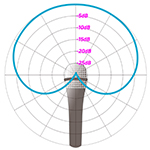
The word 'cardioid' has already made many rounds in our pages circling Martin Gateley's sound|kaos subs and prior to them, subs or bass systems from Bastanis/Zugspitz, Cygnus, Ecobox, Modal Akustik and Voxativ. We also heard it with the Silent Pound Challenger, Kii Three/BXT, a master tuning for Buchardt's A700 and finally Dutch & Dutch's 8C whose 'C' abbreviates the word. Cardioid aka heart-shaped refers to a dispersion pattern—or pickup pattern in microphones—that's far more directional than omni. In speakers it seriously attenuates or cancels sidewall reflections and minimizes front-wall reflections. Why that's a good thing becomes crystal once we juxtapose speaker to headphone sound. The latter eliminates the room with its reflective boundaries so also their unpredictable EQ on the time and amplitude response. If cardioid is such a hip 'n' happening concept, why haven't we heard still more about it you might now grumble.
 It's easy to see why cardioid implementations like these are also called 'folded open baffles'.
It's easy to see why cardioid implementations like these are also called 'folded open baffles'.
So today is the day that your grumble will get another cardioid crumb for breakfast. Enter Sigberg Audio's Manta, a €12.5K cardioid monitor from Norway. Though an active DSP 12" 3-way, its bass is only good to (cough!) 90Hz. That's because Sigberg make active subs so designed their monitor to mate to at least one. But this piquant peccadillo—of a costly über monitor being so LF castrated—is a good entry into what should be an obvious cardioid shadow. Wherever this dispersion pattern executes measurably effective, it sacrifices common boundary gain. If for just easy math's sake we assign a 3dB boost to each room boundary, eliminating sidewall then reducing front-wall reflections accounts for a loss of ~7.5dB. Where anti-phase cancellations include floor and ceiling, we'll sacrifice even more. It's why KEF calculated a whopping 15dB of room gain when they first published the outlandish F3 figure for their compact KC62 subwoofer. Obviously though, loss of room gain across a broad bandwidth must be compensated or the sound will get excessively lean. It's why Buchardt's cardioid master tuning has a companion tuning called 'cardioid with more bass'.
If you haven't thought this subject through, you'll already be snickering in amusement over yet another audiophile idiocy. Why throw away free room gain only to enforce subsequent compensation? Isn't that stupid? Only if we forget the previous speaker/headfi comparo. The cardioid advantage isn't primarily of frequency response though avoidance or minimization of room modes certainly improves it. It's primarily about time fidelity. It audibly improves by deleting common delay from late-arriving sonic reflections. This timing gain is simply paid for in room-gain currency. It's why a Kii Three is loaded with what looks like ludicrous power. It needs that much voltage/current gain to compensate the room-gain loss in the lower frequencies. Its compensation happens automatically in DSP and scales up even more with the BXT to service larger rooms and still higher SPL. It also explains why cardioid bass systems need big woofers. That's true already for their relatives, the conventional open-baffle dipoles. Looking at the new Manta shows a very lossy box. The slots in the front and on the sides allow the drivers' anti-phase emissions to exit and cancel out that portion of in-phase sound whose wavelengths wrap around the baffle; or exit the frontal slots. It's a clever way to render our room virtually invisible to the Manta. As a result, its sound doesn't carry the room's resonant signature to anywhere near the same degree as a conventional speaker. And that's the whole cardioid point. It's about hearing more direct and less reflected sound.

Related to this subject is structural gain particularly from suspended floors. Like a boom truck's chassis amplifies its sound, a suspended floor will amplify the low frequencies of speakers and subs which couple to it. It's another form of time-delayed room gain which can be eliminated with so-called isolation footers or platforms that disrupt physical transmission. Excellent examples come from Japanese company Wellfloat. For today that's merely a cursory footnote on the Big C of cardioid calls. If you're still of the opinion that slow bass is a myth, you know better now. Anything that arrives late is slow by definition. Bass frequencies are long enough to wrap around any speaker cabinet shy of an in-wall woofer aka infinite baffle. They're free to propagate equally in all directions. That reflects them off all room boundaries and hard furnishings. Thus we hear far more reflected than direct bass. Again, all reflected components are late to varying degrees. Most rooms show quite a discrepancy between frequency and severity of time delay. The low registers tend to ring longer than the treble. Reducing reflective energies with strategically more directional dispersion lessens that discrepancy to give us greater textural linearity as we descend in frequency. If you were still of the opinion that all bass is omnidirectional, you know better now, too. Cardioid dispersion is a different animal. So is dipole's figure 8 and the half-space pattern of in-walls. Meow.